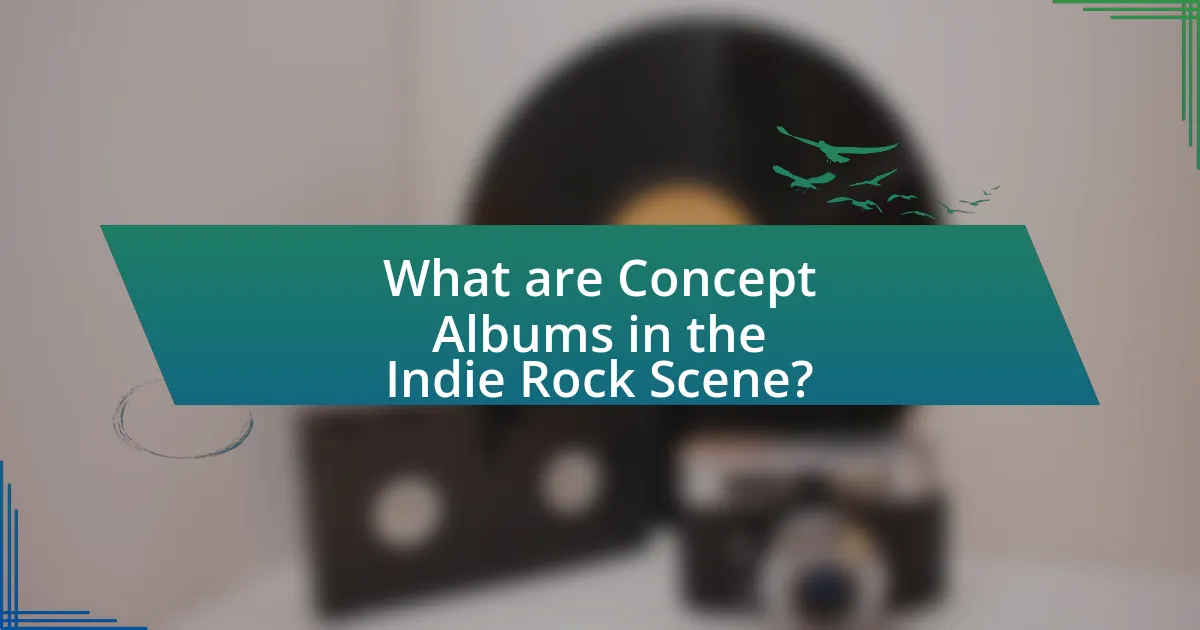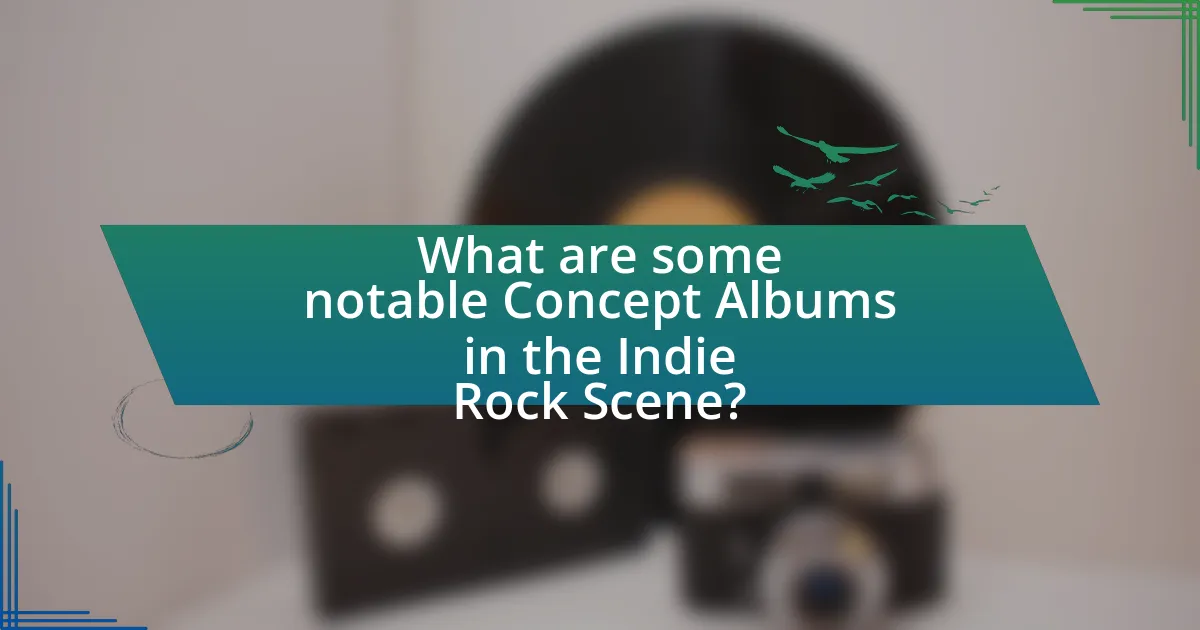The article examines the trend of concept albums within the indie rock scene, highlighting their cohesive narratives and thematic structures that differentiate them from traditional albums. It discusses the historical context that has shaped this trend, the elements that define concept albums, and their growing popularity due to the demand for immersive listening experiences. Additionally, the article explores how technology has facilitated the development of concept albums, the impact of narratives on listener engagement, and notable examples and artists that have contributed to this artistic format. Key themes explored in recent concept albums, as well as critiques and best practices for creating successful works, are also addressed.

What are Concept Albums in the Indie Rock Scene?
Concept albums in the indie rock scene are cohesive works that revolve around a central theme or narrative, often exploring complex ideas or storytelling through music. These albums typically feature interconnected songs that contribute to an overarching concept, allowing artists to express deeper artistic visions. Notable examples include “The Suburbs” by Arcade Fire, which reflects on suburban life and its implications, and “The Hazards of Love” by The Decemberists, which tells a fantastical story through its tracks. The use of concept albums has gained traction in indie rock, as artists seek to create immersive listening experiences that engage audiences on multiple levels.
How do Concept Albums differ from traditional albums?
Concept albums differ from traditional albums primarily in their narrative structure and thematic coherence. While traditional albums often consist of standalone songs that may not relate to each other, concept albums are designed around a central theme or story that connects all the tracks, creating a cohesive listening experience. For example, Pink Floyd’s “The Wall” is a seminal concept album that explores themes of isolation and personal struggle, illustrating how the songs collectively contribute to a larger narrative. This intentional design in concept albums enhances the emotional and artistic expression, setting them apart from the more fragmented approach of traditional albums.
What elements define a Concept Album in indie rock?
A concept album in indie rock is defined by a cohesive narrative or thematic structure that connects the songs. This narrative often explores complex themes such as personal experiences, social issues, or fictional stories, creating a unified listening experience. For example, albums like “The Suburbs” by Arcade Fire and “The Hazards of Love” by The Decemberists exemplify this by weaving intricate tales throughout their tracks, enhancing the emotional depth and engagement for listeners. The use of recurring motifs, lyrical callbacks, and interludes further solidifies the album’s concept, making it more than just a collection of songs.
Why are narratives important in Concept Albums?
Narratives are important in concept albums because they provide a cohesive storyline that enhances the listener’s experience and engagement with the music. This storytelling aspect allows artists to explore complex themes and emotions, creating a deeper connection with the audience. For instance, Pink Floyd’s “The Wall” uses a narrative to address issues of isolation and mental health, which resonates with listeners on multiple levels. By integrating narratives, concept albums can transform individual songs into a unified artistic statement, making the overall work more impactful and memorable.
What historical context has shaped the trend of Concept Albums in indie rock?
The trend of concept albums in indie rock has been shaped by the evolution of artistic expression in music, particularly influenced by the 1960s and 1970s rock movements. During this period, artists like The Beatles and Pink Floyd popularized the concept album format, which allowed for cohesive storytelling and thematic exploration across multiple tracks. This historical context laid the groundwork for indie rock musicians to adopt and adapt the concept album format, enabling them to create immersive narratives and explore complex themes. The resurgence of DIY ethics in the 1990s, alongside the rise of independent labels, further encouraged artists to experiment with album structures, leading to a flourishing of concept albums in the indie rock genre.
How did the evolution of indie rock influence the rise of Concept Albums?
The evolution of indie rock significantly influenced the rise of concept albums by fostering artistic freedom and encouraging narrative-driven music. As indie rock emerged in the 1980s and 1990s, artists sought to differentiate themselves from mainstream pop, leading to a focus on cohesive themes and storytelling within albums. This shift is exemplified by bands like The Decemberists and Neutral Milk Hotel, whose works, such as “The Crane Wife” and “In the Aeroplane Over the Sea,” respectively, showcase intricate narratives that engage listeners on multiple levels. The DIY ethos prevalent in indie rock also allowed musicians to experiment with unconventional structures and concepts, further promoting the creation of albums that are unified by a central idea or story.
What role did technology play in the development of Concept Albums?
Technology significantly influenced the development of concept albums by enabling artists to experiment with sound and narrative structure. The advent of multi-track recording in the 1960s allowed musicians to layer instruments and vocals, creating a more complex and cohesive sonic experience that supports a thematic narrative. For instance, albums like Pink Floyd’s “The Dark Side of the Moon” utilized advanced studio techniques to weave together songs into a unified story, showcasing how technology can enhance artistic expression. Additionally, the rise of digital audio workstations in the late 20th century further democratized music production, allowing independent artists in the indie rock scene to create concept albums with high production values without the need for major label backing. This technological evolution has been crucial in shaping the landscape of concept albums, making them more accessible and diverse in the indie rock genre.

Why are Concept Albums gaining popularity in the Indie Rock Scene?
Concept albums are gaining popularity in the Indie Rock scene due to their ability to create cohesive narratives and immersive listening experiences. This format allows artists to explore complex themes and emotions, engaging listeners on a deeper level. The rise of streaming platforms has also facilitated this trend, as audiences increasingly seek out albums that offer more than just individual singles, leading to a resurgence in the appreciation for storytelling through music. Additionally, successful examples like “The Suburbs” by Arcade Fire, which won the Grammy for Album of the Year in 2011, demonstrate the commercial viability and artistic merit of concept albums, further encouraging indie artists to adopt this approach.
What factors contribute to the resurgence of Concept Albums?
The resurgence of concept albums is primarily driven by the desire for cohesive storytelling in music, which resonates with audiences seeking deeper emotional connections. This trend is supported by the rise of streaming platforms that allow listeners to engage with entire albums rather than individual tracks, fostering an appreciation for thematic continuity. Additionally, artists in the indie rock scene are increasingly influenced by cinematic storytelling techniques, which enhance the narrative quality of their work. The success of recent concept albums, such as “The Age of Adz” by Sufjan Stevens, demonstrates that audiences are receptive to complex narratives, further validating this resurgence.
How do artists use Concept Albums to express their creativity?
Artists use concept albums to express their creativity by crafting a cohesive narrative or theme that unfolds throughout the entire album. This approach allows musicians to explore complex ideas, emotions, and stories in a structured format, enhancing the listener’s experience. For instance, Pink Floyd’s “The Wall” delves into themes of isolation and mental health, illustrating how a unified concept can deepen the impact of the music. Additionally, artists like Sufjan Stevens in “Illinois” utilize historical and cultural references to create a rich tapestry of sound and meaning, showcasing their artistic vision through interconnected tracks. This method not only highlights their creativity but also invites listeners to engage with the album on multiple levels, making concept albums a powerful tool for artistic expression in the indie rock scene.
What impact do Concept Albums have on listener engagement?
Concept albums significantly enhance listener engagement by providing a cohesive narrative that encourages deeper emotional and intellectual investment. This format allows artists to explore complex themes and storytelling, which can lead to a more immersive listening experience. Research indicates that listeners are more likely to engage with music that tells a story, as it fosters a connection between the artist and the audience. For instance, a study published in the Journal of Popular Music Studies highlights that concept albums often result in higher listener retention and repeated plays, as audiences seek to uncover layers of meaning within the album’s narrative structure.
How do Concept Albums reflect cultural and social themes?
Concept albums reflect cultural and social themes by weaving narratives that address societal issues, personal experiences, and collective identities. For instance, albums like “The Wall” by Pink Floyd explore themes of alienation and societal pressure, resonating with listeners during times of political unrest in the 1970s. Similarly, Sufjan Stevens’ “Illinois” delves into American history and identity, highlighting cultural narratives through its storytelling. These albums often serve as a commentary on contemporary issues, allowing artists to engage with their audience on a deeper level, thus reinforcing the connection between music and the cultural context in which it is created.
What are some common themes explored in recent Concept Albums?
Recent concept albums often explore themes such as personal identity, mental health, societal issues, and existentialism. For instance, albums like “The Age of Adz” by Sufjan Stevens delve into the complexities of mental illness and personal struggle, while “The Black Parade” by My Chemical Romance addresses themes of death and the afterlife. Additionally, albums like “A Moon Shaped Pool” by Radiohead reflect on environmental concerns and human disconnection. These thematic explorations resonate with listeners, providing a narrative depth that enhances the overall musical experience.
How do Concept Albums address contemporary issues in society?
Concept albums address contemporary issues in society by weaving narratives that reflect social, political, and cultural themes relevant to current events. For instance, albums like “American Idiot” by Green Day critique American politics and consumerism in the post-9/11 era, highlighting disillusionment among youth. Similarly, “To Pimp a Butterfly” by Kendrick Lamar explores racial identity and systemic oppression, resonating with movements like Black Lives Matter. These albums utilize storytelling and thematic cohesion to engage listeners with pressing societal concerns, making complex issues accessible and relatable through music.

What are some notable Concept Albums in the Indie Rock Scene?
Notable concept albums in the indie rock scene include “The Suburbs” by Arcade Fire, “The Hazards of Love” by The Decemberists, and “Yankee Hotel Foxtrot” by Wilco. “The Suburbs,” released in 2010, explores themes of suburban life and nostalgia, earning the Grammy Award for Album of the Year. “The Hazards of Love,” a rock opera from 2009, tells a narrative of love and tragedy, showcasing The Decemberists’ storytelling prowess. “Yankee Hotel Foxtrot,” released in 2002, features experimental sounds and addresses themes of isolation and disconnection, solidifying Wilco’s status in the indie rock genre. These albums exemplify the artistic depth and narrative complexity that characterize concept albums within the indie rock scene.
Which artists are known for their influential Concept Albums?
Artists known for their influential concept albums include Pink Floyd, whose album “The Wall” explores themes of isolation and personal struggle, and The Who, recognized for “Tommy,” which tells the story of a deaf, dumb, and blind boy. Additionally, David Bowie is notable for “The Rise and Fall of Ziggy Stardust and the Spiders from Mars,” which presents a narrative about an androgynous rock star. These albums have significantly impacted the music industry by integrating storytelling with musical composition, influencing countless artists in the indie rock scene and beyond.
What are the key features of these notable Concept Albums?
Key features of notable concept albums in the indie rock scene include a cohesive narrative, thematic consistency, and innovative musical structures. These albums often tell a story or explore a central theme throughout the tracks, creating a unified listening experience. For example, “The Suburbs” by Arcade Fire addresses themes of nostalgia and suburban life, while “The Hazards of Love” by The Decemberists presents a narrative-driven experience with distinct characters and plot developments. Additionally, concept albums frequently experiment with musical styles and arrangements, enhancing the storytelling aspect through varied instrumentation and production techniques. This approach not only engages listeners but also elevates the artistic expression within the genre.
How have these albums impacted the indie rock genre?
These albums have significantly shaped the indie rock genre by introducing narrative-driven structures that enhance thematic depth. Concept albums like “The Suburbs” by Arcade Fire and “The Hazards of Love” by The Decemberists have pushed artists to explore complex storytelling, leading to a richer listening experience. This trend has influenced a wave of indie musicians who now prioritize cohesive narratives in their work, as evidenced by the critical acclaim and commercial success of such albums, which have collectively garnered multiple Grammy Awards and widespread recognition in music charts.
What critical reception have Concept Albums received in the indie rock community?
Concept albums have generally received a positive critical reception in the indie rock community, often praised for their artistic ambition and cohesive storytelling. Critics highlight that these albums allow artists to explore complex themes and narratives, which can lead to a deeper emotional connection with listeners. For instance, albums like “The Suburbs” by Arcade Fire and “The Hazards of Love” by The Decemberists have been lauded for their intricate concepts and musical execution, earning accolades from major publications such as Pitchfork and Rolling Stone. This trend reflects a broader appreciation within the indie rock scene for innovative approaches to album-making that challenge traditional song structures and engage audiences on multiple levels.
How do critics evaluate the success of Concept Albums?
Critics evaluate the success of concept albums primarily through thematic coherence, musical innovation, and emotional impact. Thematic coherence refers to how well the album’s narrative or concept is developed and maintained throughout the tracks, with successful albums often telling a compelling story or exploring a unified theme. Musical innovation assesses the originality and creativity of the sound, including the use of instrumentation and production techniques that push boundaries. Emotional impact measures how effectively the album resonates with listeners, often reflected in critical reviews and audience reception. For instance, albums like “The Wall” by Pink Floyd and “American Idiot” by Green Day are frequently cited as successful concept albums due to their strong narratives, innovative soundscapes, and profound emotional connections with audiences.
What are some common critiques of Concept Albums in indie rock?
Common critiques of concept albums in indie rock include perceived pretentiousness, lack of accessibility, and narrative coherence issues. Critics argue that the ambitious storytelling often leads to overly complex themes that alienate casual listeners. For instance, some albums may prioritize artistic vision over musicality, resulting in tracks that feel disconnected or lack standalone appeal. Additionally, the focus on a cohesive narrative can sometimes lead to filler content, diluting the overall quality of the music. These critiques highlight the tension between artistic ambition and listener engagement within the indie rock genre.
What are the best practices for creating a successful Concept Album?
To create a successful concept album, artists should ensure a cohesive narrative that connects all songs, enhancing the overall listening experience. This involves developing a central theme or story that guides the lyrics and musical composition throughout the album. For instance, Pink Floyd’s “The Wall” exemplifies this practice by weaving a complex narrative about isolation and personal struggle, which resonates deeply with listeners. Additionally, artists should focus on consistent musical motifs and stylistic elements that reinforce the theme, as seen in The Decemberists’ “The Hazards of Love,” where recurring musical themes tie the story together. Engaging artwork and packaging that reflect the album’s concept can further enhance the listener’s connection, as demonstrated by the visual storytelling in the album art of Arcade Fire’s “The Suburbs.” These practices collectively contribute to a more immersive and impactful concept album experience.
How can artists effectively develop a narrative for their Concept Album?
Artists can effectively develop a narrative for their Concept Album by establishing a clear theme or storyline that resonates throughout the tracks. This involves outlining the central message or emotional journey they wish to convey, which can be inspired by personal experiences, societal issues, or fictional tales. For instance, Pink Floyd’s “The Wall” illustrates a cohesive narrative about isolation and alienation, demonstrating how a well-defined concept can enhance the listener’s experience. Additionally, artists should create character arcs or scenarios that evolve across the album, allowing for a dynamic progression that keeps the audience engaged. By integrating musical motifs and lyrical callbacks, they can reinforce the narrative, making it more memorable and impactful.
What strategies can be employed to enhance listener experience with Concept Albums?
To enhance listener experience with concept albums, artists can employ immersive storytelling techniques that engage the audience emotionally and intellectually. By crafting a cohesive narrative throughout the album, musicians can create a deeper connection with listeners, as evidenced by successful concept albums like Pink Floyd’s “The Wall,” which integrates music with a compelling storyline. Additionally, incorporating visual elements such as album art, music videos, and live performances that reflect the album’s themes can further enrich the listener’s experience. Research indicates that multi-sensory engagement significantly increases emotional responses, making the overall experience more memorable and impactful.




